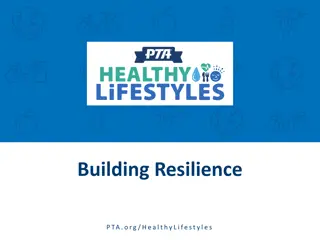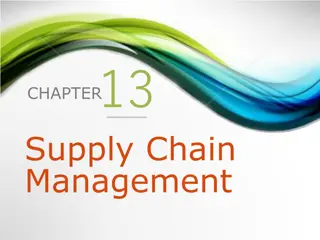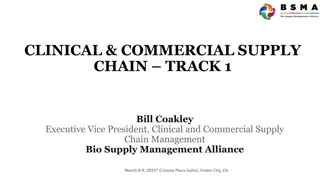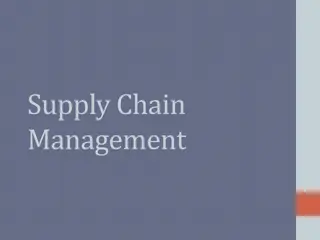
Enhancing Supply Chain Resilience with Key Performance Indicators
Explore the significance of Key Performance Indicators (KPIs) in supply chain resilience planning. Learn how KPIs help organizations measure performance, evaluate success, and ensure continuity in the face of disruptions like disasters. Discover examples of resilience KPIs and how they contribute to enhancing overall business resilience.
Download Presentation

Please find below an Image/Link to download the presentation.
The content on the website is provided AS IS for your information and personal use only. It may not be sold, licensed, or shared on other websites without obtaining consent from the author. If you encounter any issues during the download, it is possible that the publisher has removed the file from their server.
You are allowed to download the files provided on this website for personal or commercial use, subject to the condition that they are used lawfully. All files are the property of their respective owners.
The content on the website is provided AS IS for your information and personal use only. It may not be sold, licensed, or shared on other websites without obtaining consent from the author.
E N D
Presentation Transcript
Supply Chain Resilience Planning Using Key Performance Indicators Paul Kirvan Associates https://www.linkedin.com/in/paulkirvan 2
Agenda Introduction What KPIs are and how they are used Supply chain considerations using KPIs Using KPIs for supply chain resilience planning 3
Introduction Resilience activities, such as business continuity and disaster recovery, are all about metrics This session discusses a key resilience metric Key Performance Indicator (KPI) and how it adds value to resilience initiatives In this program we will discuss the value of KPIs in supply chain resilience activities 4
Key Performance Indicators A key performance indicator (KPI) is a measure of performance, or how well specific outcomes are achieved based on pre-defined processes and procedures 5
Key Performance Indicators KPIs help an organization define and evaluate how successful it is, typically in terms of making progress towards long- term organizational and business goals "What is really important to our company and its supply chains?" 6
Key Performance Indicators How KPIs can be used: Monitor and analyze KPIs to assess the current state of the business and/or technology MONITOR Identify corrections that ought to be made IDENTIFY Prescribe a course of action PRESCRIBE MEASURE Measure the results 7
Key Performance Indicators Frequently used to "value" difficult-to-measure activities: Benefits of Leadership Development Quality of Service (inside and outside) Customer Satisfaction 8
Key Performance Indicators Examples of resilience KPIs: Recovery Time Objective Recovery Point Objective Service Level Agreements Operational Level Agreements Supply Chain Performance Levels Frequency of Training Frequency of Exercising 9
Key Performance Indicators Supply chain planning considerations using KPIs: Pre-defined and established business processes, such as supply chains Requirements for supply chain processes and how they should perform Quantitative/qualitative measurement of the results and comparison with established goals Identifying variances and adjusting processes and/or resources to achieve short-term goals Determine if supply chain resilience activities are providing value for the investment 10
Key Performance Indicators Examples of Supply Chain Resilience Planning KPIs: Complete two (2) plan exercises annually 1 Update all supply chain BIAs annually 2 Update all supply chain risk assessments annually 3 Review/reconfirm roles and responsibilities for resilience and emergency teams quarterly 4 Confirm accuracy of supply chain contact lists with internal databases on a bi-monthly basis 5 11
Key Performance Indicators Examples of Supply Chain Resilience Planning KPIs: Review/audit all supply chain resilience plans annually 6 Conduct training for all resilience team members twice annually 7 Conduct an annual top management briefing on supply chain resilience activities 8 Conduct employee supply chain resilience awareness briefings quarterly 9 12
Key Performance Indicators Use KPIs in supply chain resilience planning by organizing KPI criteria into indexes that measure operational risks: Supply Chain Resilience Index - Track vulnerability and criticality of processes, quality of supply chain resilience (e.g., BC and DR) plans and the frequency and adequacy of practices and tests Information Technology Index - Track availability and performance of technology at critical time periods for critical business purposes 13
Key Performance Indicators When building KPIs into supply chain resilience planning, identify how well specific activities should occur and/or be executed, as well as other specific performance metrics Focus KPIs on what specific supply chain resilience activities should be performed, when they should be completed, how well they are executed Use KPIs to identify opportunities for supply chain performance improvement 14
Key Performance Indicators Considerations for adding KPIs to supply chain resilience planning: Top management and audit support Budget for initiatives Perform upfront research (e.g., risk/performance metrics, experience of other organizations) Documentation (e.g., assume resources are available) Step-by-step procedures for adding KPIs to supply chain resilience planning initiatives Conduct follow-up activities after the initiative launches (e.g., was the anticipated value achieved?) 15
Key Performance Indicators Planning guidelines: Determine how KPIs can add value to existing supply chain resilience programs and new initiatives Ensure the use of these metrics is acceptable to management and audit Begin defining relevant metrics and develop indexes and reporting on supply chain resilience performance Develop a plan to incorporate the metrics in supply chain resilience programs and related activities Integrate KPIs with program management activities Use results from KPI initiatives to identify opportunities for supply chain program improvement 16
Key Performance Indicators Thank you Paul Kirvan Associates https://www.linkedin.com/in/paulkirvan 17






















